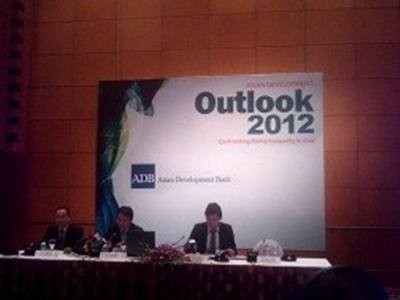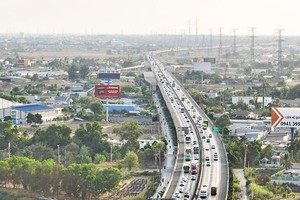Asian Development Bank released its annual publication, the Asian Development Outlook 2012 (ADO) on April 11, in which it forecasts that Vietnam’s GDP growth rate would slow to 5.7 per cent in 2012 before picking up to 6.2 per cent in 2013.

Inflation is forecast to trend down this year, reflecting policy tightening and strong base set for consumer price index in 2011.
Food price inflation is abating. Weather conditions for agriculture were generally favourable in the first quarter of 2012 and global food prices are projected to ease this year.
Average inflation this year could ease to just under double digits, provided policy settings are kept sufficiently firm. However, experts said that core inflation, which excludes food and energy, will be more persistent.
Year average inflation in 2013 is seen quickening to 11.5 per cent due to economic growth and on expectations of higher global food prices and hikes in domestic electricity and fuel costs.
ADO supported Government focus on structural reforms in 2012 but stressed for increased transparency necessary for the reform process, particularly in state-owned enterprises.
Rapid credit growth in recent years followed by a credit squeeze in 2011, and exacerbated by downturn in the property and equities markets, have added to stress in banks. Exposure to unprofitable and overstretched state-owned enterprises (SOEs), further raises questions about capital adequacy.
ADO commended plans by the Government to restructure the financial sector but noted that funding and timing of bank recapitalization have not been disclosed in detail. ADO also noted that the State Bank of Vietnam needed to gradually move towards risk-based system of supervision to ensure banking sector soundness.
The current account is forecast to record a deficit equivalent to 1.5 per cent of GDP in 2012 and 2.2 per cent in 2013, largely due to subdued exports. This outlook would be at risk if the government were to ease policies at a pace unsettling the foreign exchange market.
Real savings of dong depositors have been eroded by negative interest rates over a prolonged period. The cumulative “errors and omissions” in the balance of payments, estimated at $18 billion in 2009-2011, reflects large volumes of foreign currency and gold outside the banking system.
Lowering interest rates too quickly could put the dong under renewed pressure. This would undermine macroeconomic stabilization efforts, erode investor and consumer confidence, and undermine foreign reserves. Vulnerabilities in the banking system also pose a risk. Business confidence and the financial system would be shaken if problems in small banks were to spread.
While foreign reserves have been rebuilt, they are still low, making the economy vulnerable to external shocks. On the fiscal side, the costs of recapitalizing banks, restructuring state-owned enterprises, and raising civil service wages to compensate for rapid inflation puts at risk public capital spending.
The ratio of current to capital expenditure increased significantly last year. Additionally, an increasing proportion of government spending is being channeled off budget, raising public financial management risks.
In the report, ADB also gives judgment of economic trends and prospects in developing Asia.
Asia region’s GDP grew by 6.9 per cent in the year, meanwhile it was 7.2 per cent in 2011; however, it will be 7.3 per cent next year. Among Asian countries, China, the world’s second largest economy, will grow by 8.5 per cent in 2012 and by 8.7 in 2013. India will be 7.5 per cent this year.
Southeast Asia’s GDP will be 5.2 per cent in 2012, slightly higher than 4.6 per cent in 2011, as Thailand recovers from the recent severe flood. The report said that Asia will have more sustainable and long term growth as it bases on domestic needs rather than exports.
























